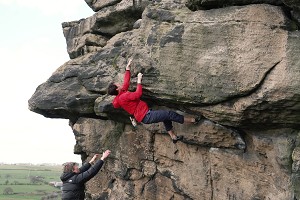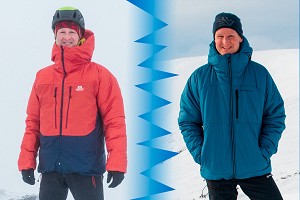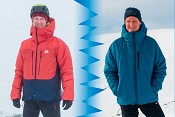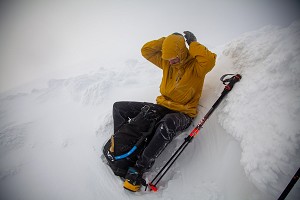
Rab's latest synthetic insulated jacket, the Cirrus Ultra, combines a heat-reflective lining with down-like loose fill insulation to give you a jacket that's very warm for its weight, which performs well even when damp, and which costs substantially less than a down duvet of similar weight and performance. In fact we think you'd struggle to buy a warmer jacket for just £230. Whether you're bouldering on a chilly day, camping in the bridge seasons, or (within limits) heading for the winter mountains, it's a versatile and budget-friendly midweight option. There's a lot to like about the Cirrus Ultra; but it comes with a big drawback too, because synthetic insulation that behaves like down is both a good thing and, in some respects, less good.
Insulation - what's in it?
To give you something this toasty at a modest weight, Rab have combined two things: a heat-reflective TILT lining (as seen on some of their down products); and PrimaLoft's Thermo Plume+ insulation. Much like down, this loose fill comes in tiny individual plumes that are blown into the jacket. It compresses very well, and has a great loft that makes it feel really warm; in fact you could easily mistake the Cirrus Ultra for a down jacket.
But also like down, and unlike synthetic sheet insulation, this fill is prone to migrating around inside the garment. As a result the Cirrus Ultra has lots of stitched baffles, which means it's not very wind resistant and has many cold spots. This issue is exacerbated by the way the Thermo Plume tends to clump up within each baffle, leaving noticeable empty areas with no insulation at all - particularly (but not exclusively) at the elbows and wrists, where the jacket flexes a lot. Wear the Cirrus Ultra on a cold day over just a t-shirt and you will know about it right away. Manually redistributing the fill every so often helps a bit, but the fact remains that this is a weakness of the design, at least for use in more serious environments.
To partly address this, Rab have used a more robust sheet insulation over the top of the shoulders, where the jacket gets compressed by rucksack straps, and along the underside of the sleeves.
In use
Penny:
I've used the Cirrus Ultra whilst out climbing - particularly bouldering - during the winter months. Bouldering is very much a case of feast or famine as far as warmth is concerned, because you tend to warm up when on the rock, then get quite cold when you're not - and whilst bouldering you spend a LOT of time stood around. The Cirrus Ultra provides a good level of insulation, particularly around the body, and that's definitely helped to keep me warm; however, there are clearly issues around the elbows and wrists, where the insulation tends to migrate into the centre of the baffles, leaving large blank spots which create quite cold patches.

Dan:
I've worn my Cirrus Ultra throughout winter and now into early spring, using it for everything from dog walks and general out-and-about days to proper Scottish winter mountain trips. Whilst it has fared fine on the hills, and certainly provides plenty of insulation for its modest weight and good packability, I am not convinced it's the best choice for warmth-critical uses in more consequential places, thanks to all the stitched baffles that noticeably let the breeze through, and the clumping tendency of the fill that clearly lets heat out. If you're winter mountaineering or winter hillwalking, where a reliable and robust jacket is a health and safety concern, I would opt instead for a Rab Generator Alpine or equivalent - something with sheet insulation, not Thermo Plume.
Weight and packability
Dan
At 562g in my men's size L (Rab say 494g women's size 10) the Cirrus Ultra is pretty light for the warmth it offers - even accounting for the fill migration. In terms of weight it's on a par with the Generator Alpine, and if you want something substantially warmer at this sort of half-kilo level then you'll need to power up to a pricy down jacket such as the Mythic Ultra. While the Generator Alpine is definitely preferable as a synthetic alternative for use as a winter mountain belay jacket, the Cirrus Ultra does have packability going for it, squashing into one of its own pockets to give you a bundle that stuffs easily into a day pack and would be alright to hang off a harness (clip loop provided).
Fit
Penny:
The Cirrus Ultra has a really nice generous cut, and it's long enough to cover your hips and any gaps between your top and bottom layers, which - if you're stood around for ages - is exactly what you want. The sleeves are plenty long enough too, and sufficiently loose for a climber's forearms, which makes it much easier to slip on and off between attempts on your boulder problem.
Dan:
There's plenty of room to wear the jacket over several thinner layers, making it a good option for cold weather walks or a winter summit stop - though I don't feel it's sized quite generously enough in the sleeves and underarms to serve as an over-your-waterproofs winter belay jacket in the manner of a Generator Alpine. Hem length is good, giving full bum coverage to keep draughts at bay. The simple stretch-bound cuffs fit fine over bulky gloves - no need for a velcro tab.
Crucial on any jacket that wants to be taken seriously in the mountains is a hood that works with a helmet. The Cirrus Ultra's is big enough to fit over one, though I find the collar then pulls a bit tight on my chin when looking up with the zip fully fastened (something you do a lot on a winter belay). Without a helmet the hood can be tightened around your face, although the brim then tends to droop down over your eyes. Overall I'm not wowed by this hood, but it does the job.
Features
Penny:
There's just enough room to fit your climbing shoes into the pockets, but only just. It would have been nice if there were a couple of internal pockets and sleeves you could dump them into, as this would leave the handwarmer pockets for your hands. Whilst the chest pockets do provide a useful space to store your phone, the material is extremely thin, which means they don't provide any protection, or any warmth - which can lead to your battery running out a lot quicker.
Dan:
Four external pockets is loads, and they're all big enough to hold bulky things like hat and ski gloves. The hand pockets are worth having on a jacket that will mostly be used for hands-in-pockets strolling rather than full-on mountaineering, but I share Penny's reservations about the uninsulated chest pockets.
Ethics and environment
According to Rab's Material Facts, the Cirrus Ultra uses an impressive 87% recycled content - something worth shouting about. It also has a fluorocarbon-free DWR.
Summary
Warm for its weight, comfy, and easy to get on with, this versatile 'synthetic down' jacket has a lot going for it. Its unfortunate issue with fill migration is perhaps a forgivable annoyance in general outdoor wear, but for more consequential mountain use this Thermo Plume insulation just doesn't seem as reliably protective as conventional synthetic sheet insulation. We think winter hillwalkers and climbers would be better off looking elsewhere, but if you're bouldering in the cold, walking the dog in the snow, camping in spring, or just on the hunt for an all-round warm midweight jacket that won't break the bank, then the Cirrus Ultra would be a great choice, and superb value for money at this price.



















































Comments
Interesting, are we now getting to the point where down has had it's chips? If the cons would be the same with real down as the filling, then surely the extra expense of real down would make it uncompetitive as a filling in the world of real people spending their own money on things. How much would a technical down jacket whose design eliminates cold spots be cheaper by if it used the same TILT and Thermoplume+ insulation as this one?